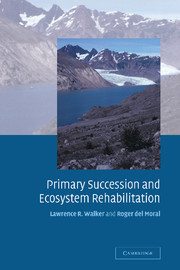Book contents
- Frontmatter
- Contents
- Preface and acknowledgements
- 1 Introduction
- 2 Denudation: the creation of a barren substrate
- 3 Successional theory
- 4 Soil development
- 5 Life histories of early colonists
- 6 Species interactions
- 7 Successional patterns
- 8 Applications of theory for rehabilitation
- 9 Future directions
- Glossary
- Illustration credits
- References
- Index
7 - Successional patterns
Published online by Cambridge University Press: 08 January 2010
- Frontmatter
- Contents
- Preface and acknowledgements
- 1 Introduction
- 2 Denudation: the creation of a barren substrate
- 3 Successional theory
- 4 Soil development
- 5 Life histories of early colonists
- 6 Species interactions
- 7 Successional patterns
- 8 Applications of theory for rehabilitation
- 9 Future directions
- Glossary
- Illustration credits
- References
- Index
Summary
In this chapter, we describe how primary successions unfold. We discuss both the trajectories and the rates of development. We explore how biodiversity and biomass change and how major environmental factors control primary succession. Although we believe that community assembly has a large stochastic element, predictable structural and functional patterns often emerge. Trajectories may not be predictable in floristic detail, but relative rates of change and the ultimate vegetation structure can be predicted (cf. Samuels & Drake, 1997). The rates and pathways of primary succession are also controlled by the landscape context and size of the recovering area. Barriers and isolation from sources of propagules limit the number and kinds of species that reach a site (see section 5.3.3 on barriers). Interactions with later arriving plants, animals and microbes (see Chapter 6) all modify the rates and trajectories. The degree of environmental stress affects the rates of biomass accumulation that in turn affects biodiversity, biomass accumulation and successional trajectories. Here we explore the longer-term consequences of these early events. We will examine community patterns that result from the trajectories of succession and explore the forces that may lead to community convergence.
Types of trajectory
Successional trajectories describe changes in species composition through time. Trajectories may follow definitive pathways, moving through well-defined ‘seres’ (stages) that lead to a predictable, stable association. In this scenario, multiple starting points converge in terms of dominant species composition. Alternatively, the course of species assembly may be less predictable without convergence.
- Type
- Chapter
- Information
- Primary Succession and Ecosystem Rehabilitation , pp. 232 - 281Publisher: Cambridge University PressPrint publication year: 2003

